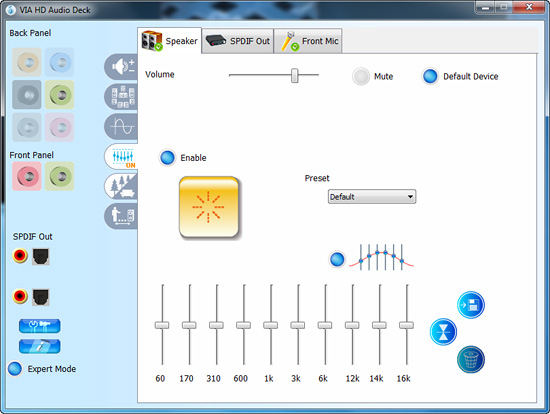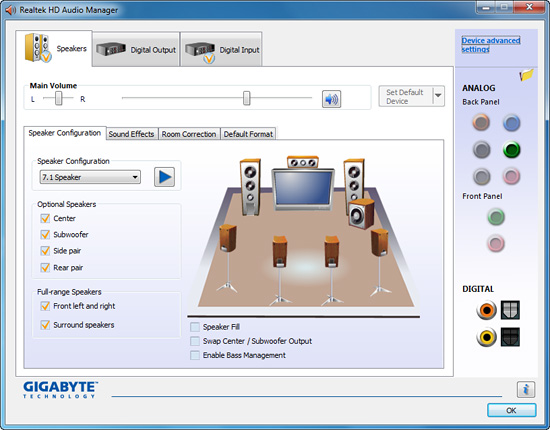Budget Micro-ATX P55 Faceoff: Gigabyte GA-P55M-UD2 and ASRock P55M Pro
by Gary Key on October 5, 2009 12:30 PM EST- Posted in
- Motherboards
Audio-
We are planning on taking an in-depth look at all of the current on-board audio codecs and compare them to a couple of discrete audio cards from ASUS and AuzenTech in the near future. In the meantime, we will provide a quick overview of the control panels from the two competing solutions today and a quick subjective analysis.

ASRock utilizes the VIA VT1708S 8-channel audio codec on the P55M Pro motherboard. To be honest, I had low expectations of this particular chipset. In actuality, it is a decent competitor to the Realtek ALC 888B utilized by Gigabyte. In fact, VIA has made great progress in their driver set and at this point I firmly believe the actual implementation by the motherboard manufacturer in regards to shielding is more important to audio quality than the any potential differences between the two chipsets.
That said, VIA has a very good control panel and option setup, certainly more so than Realtek in this particular case. The most beneficial item is the equalizer as you will need it for music playback. Midrange performance on this chipset is lacking depth and highs at times sound tinny. Both chipsets scored about even in Rightmark’s excellent Audio Analyzer software test suite with THD+ numbers slightly favoring the Realtek solution.
Unfortunately, my ears thought the difference in quality between the two solutions was a bit greater. The main problem with the VIA solution as implemented by ASRock was background noise that was directly attributable to electrical shielding problems on the board. In headphone mode, I could hear a slight background hum that would rise and fall with load activity on both the CPU and storage subsystems. It was very slight, but just enough to be noticeable in several classical and jazz soundtracks. It was also present in several games, mainly simulations and RTS games where there is not constant gunfire present in most first person shooters.

Gigabyte utilizes the Realtek ALC 888B 8-channel audio codec on the P55M Pro motherboard. Audio quality in music was better than the VIA VT1708S thanks to clearer midranges, but highs were still leaned on the tinny side and bass was even between the two chipsets.
Otherwise, I preferred the Via solution in games and movie playback, not by much, but channel separation was slightly better. Of course, if you really want better analog output a good discrete audio card is the solution. For most of us, either of the audio solutions will suffice, but thanks to the lack of background noise, we will have to give the Gigabyte board the win here.





















55 Comments
View All Comments
yehuda - Monday, October 5, 2009 - link
Slow POST is a minor annoyance, but it adds up as part of the computing experience IMO. I don't get why Gigabyte is so slow compared to other brands like MSI and ASRock. Just getting the video signal online takes about 4 seconds here (commenting on G31 and G41-based boards). It feels like a 486 until the OS takes over.yacoub - Monday, October 5, 2009 - link
Much more interested in the MSI uATX board and the higher-level Gigabyte one that actually has all the features on it. These two may be entry-level but they also skip some features most discerning enthusiasts would want.Gary Key - Monday, October 5, 2009 - link
The MSI just arrived, they were late to market for that one. The P55M-UD4 is coming up shortly, but it does not clock any better than the UD2. ;) The lack of passive MOSFET cooling was not a problem on either board under full load. The bigger problem is that the 4+1 PWM setup is not going to handle high current draws. The UD4, GD45, and MIII GENE boards are designed for that audience.MadMan007 - Monday, October 5, 2009 - link
That's simple enough to understand in a basic way but could you elaborate on what *high* current means, and what the difference in ovreclocking might be? In the context of 24/7 overclocks as you go on about in this article would be best...you seem to imply in the article that the UD2 will be as good as any at 24/7-type settings but it would be nice to clarify when 'high' current is an advantage.yacoub - Monday, October 5, 2009 - link
Cool, looking forward to that UD4 review =)I wonder if the extra features will be considered worth the price difference, although it sounds like you do not believe so.
The onboard audio is one area i've heard several complaints for cheapest Gigabyte boards compared to the mid-level and upper-tier boards.
MadMan007 - Monday, October 5, 2009 - link
What exactly were the issues or differences in the audio? Features or sound quality?yacoub - Monday, October 5, 2009 - link
at the moment i can't find either of the reviews i read a couple weeks ago, but both stated sound quality issues with the onboard solution, which is a lower grade than what is included on the other boards.philosofool - Monday, October 5, 2009 - link
I have one of these boards and the sound is great. I'm listening to Little Milton (Grits Ain't Groceries) right now: I can hear every horn, bass string, cymbal crash like I'm sitting on stage. Okay, maybe that's an exaggeration, but there's nothing wrong with the audio on this board.yacoub - Monday, October 5, 2009 - link
To be more specific, there are reviews on other sites mentioning the particularly crappy onboard audio solution on the UD2 compared to the UD4, and there's also the lack of cooling on the VRMs.On the upside, sure, it uses slightly less operating power, and that can be important to users interested in uATX, but overall I'd rather spend another $20 or whatever to get the UD4 with better cooling and audio (and whatever else it adds).
yacoub - Monday, October 5, 2009 - link
Awesome work with the review, Gary. I do wish the uATX boards would stop carrying legacy ports like others have noted. Floppy is definitely archaic, IDE should be the next item tossed, and PCI could probably go as well. FireWire is also something 99% of us could live without on a uATX board that offers USB and eSATA.